Grandmenil Panther Tank Ausf. G
This Surviving German Panzer V Panther Tank took part in the 1944 WW2 Battle of the Bulge in the Belgium Ardennes. It has been restored and can be visited in the village of Grandmenil, Belgium. You will find this PzKpfW V Ausf. G tank near the roundabout on the N807 at the junction with the Rue Alphonse Poncelet.
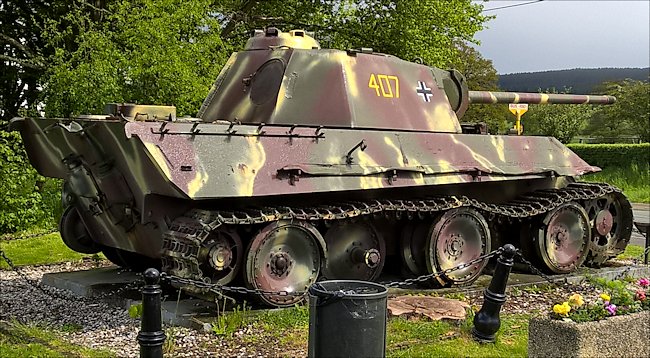
German Panther Tank PzKpfW V Ausf. G in the village of Grandmenil
It is believed that this Panzer V Ausf.G tank was part of the 2nd SS Panzer Division 'Das Reich' and just abandoned because of lack of fuel during the retreat. It was recovered in a field off the Manhay-Erezee road. It still has its engine and gear box. It so needs a clean and new paint job.
2nd SS Division Panthers in action near Freyneux
During the Battle of the Bulge in the Belgium Ardennes that started on 16th December 1944, the German offensive had come upon a few problems and this had caused delays. The 6th Panzer Army is five days behind on its schedule. Hitler orders the 2nd SS das Reich Division to move south and attempt their own break through to the bridges of the River Meus. It has 28 Panzer IV tanks, 28 self-propelled guns and 58 Panzer V Panther tanks.
German 2nd Lt. Fritz Langanke was a Panther tank commander, "In my opinion the Panther was, until the end of the war, the most functional and best tank in the world, based on three components, velocity, cross country mobility and tank protection. They, the Sherman, just did not stand a chance against the Panther tank.
By 24th December 1944 lead elements of the 2nd SS Panzer Division had nearly reached their objective, the bridge over the River Meuse at Manhay. To secure their rear 2nd Lt. Fritz Langanke and his platoon of four panther tanks are ordered to secure the town of Freyneux to the south. "We entered the village in a staggered formation. I stopped. I thought I saw vehicles so I started shooting. At the same time American tanks started shooting at us. It was an ambush."
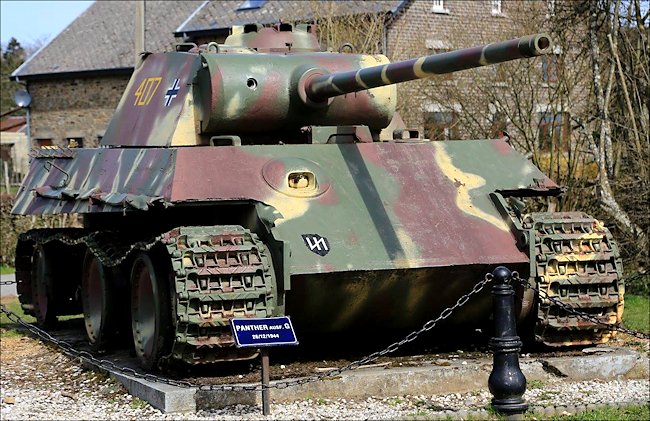
The sloping frontal amour protected this Panzer V Panther Tank. Most Allied tank shells could not penetrate it, many just bounced off.
The Sherman M4A3 had a relative under powered 75 mm short barrelled cannon. It could not penetrate the front armour of the German Panther Tank but if it was close it could penetrate the 50mm armour on the side and rear of the Panther.
2nd Lt. Fritz Langanke continued, "I recognised a Sherman on the left side of the street and fired at it. I received lots of hits on my front armour. Most bounced off but one hit the right hand weld. It burst and all of a sudden we had sunlight coming through into the tank. It is an enormous noise inside. Your nerves have to be solid for that for sure. We had them."
"The other Panthers had been hit as well, from the side and front. I saw one of their gun barrels fall off but they were able to drive back with the others. I drove backwards as well keeping our front armour facing to the front. We returned to a bluff of land that hid us from the Americans, and stopped there."
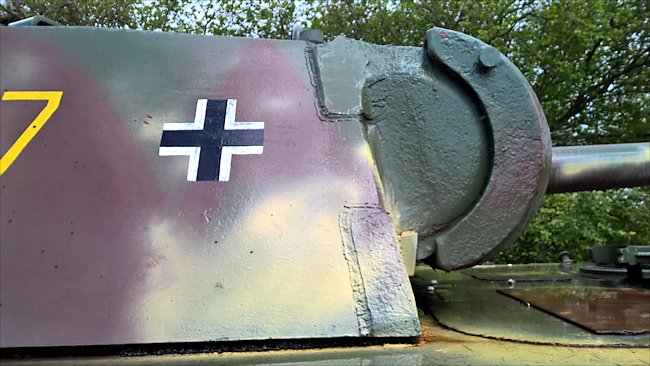
"I was pretty sure that it was only a question of time the Americans would turn up here as well. In the mean time I did some observation on the area around us. I fired on three different points, like a tree, to get the range exactly. This is a common procedure for measuring the distance for firing the cannon later, to assure 100% hits. It was a good thing I had prepared this before because shortly after five Shermans showed up."
"I was hull down behind the bluff. All they could see was my turret. The distance was not that long, maybe 500 to 650 metres. As I had the exact distances I managed to shoot the first four Shemans with only one round each. The last one tried to back off but I managed to reach that one as well."
Night attack to the Manhay and Grandmenil Road by SS Panther Tanks
Panther tank 401 commander Oberscharfuhrer Ernst Barkmann, 3rd Platoon Leader, 2nd SS Panzer Regiment (SS-Pz.Rgt.2) provided an account of his panzer's night advance into American held territory during the Battle of the Bulge along the Manhay and Grandmenil road.
"I caught my breath. In the open grassy area in front of us I counted nine enemy Sherman tanks close beside each other. They all had the muzzles of their guns pointing threateningly at our tanks, which till then had been moving unsuspectingly directly towards them. Our driver Graundmeyer, recognise the danger. He was really taken aback. Standing still or retreating would be suicidal. Only bluff could still save us. So it was a question of escaping in a forwards direction."
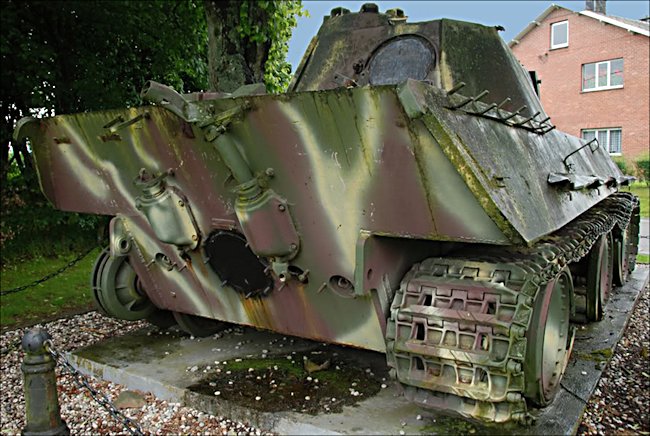
The sloping side armour on this Panzer V Ausf.G Panther Tank was 50mm thick
"The commanders orders to the driver were, 'Move on ahead without reducing speed'. Perhaps we would succeed in passing around them without being recognised because they were thinking that we were their own tanks. We advanced along the bend, showing them the full length of our sites and with nine turrets threatening us."
"Their gunners really had us in the bag. But not a shot was fired. As soon as we were on their flank and I could pick out the backs of all the enemy tanks drawn up behind each other, I called halt. We had the best firing position and in fact had only one enemy tank to deal with. All the rest were blocking each others field of fire. I had let the Panther's turret swing around to 3 o'clock, to the right, so as to let the gunner get targets in his sights."
"Then I could not believe my eyes. Those American tank crews jumped out, rushed headlong from their tanks and charged into the shelter of parts of the forest that lay behind them. This changed the situation for us once again. I knew that Franuscher's Panther tank was behind me. I was aware of the companies combat plans to keep moving. I had come to grips with an adversary who, in night fighting at least, was inexperienced and could be thrown into confusion. We had to make use of this advantage in the context of the entire operation. Radio contact with the company was still unobtainable."
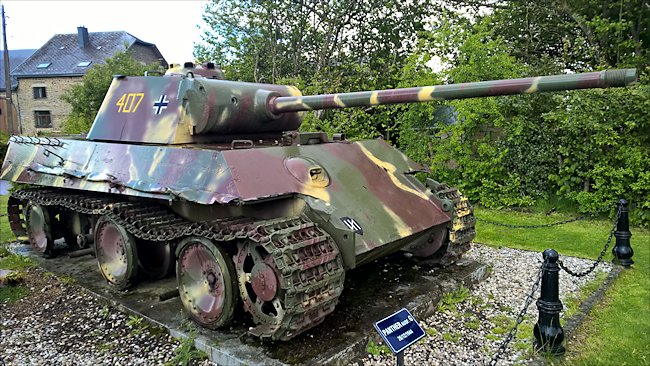
The Grandmenil Panther is missing its muzzle break at the end of the 75mm gun
"All on my own, I decided to have the turret turned to 12 o'clock, facing forward. I gave the order, 'tanks forward'. We would have been very happy to knock out the enemy tanks but this would have alerted the whole enemy front. Also, our friend Frauscher, who followed us took care of that. According to his report, he bagged all nine of them."
"We moved on towards Manhay. The forest closed in on us again. Singularly at first, then in groups and columns, there were American infantry pulling out onto the road from the right side of the forest. For reasons I could not understand the enemy was disengaging. We were moving through the middle of them without taking any special care."
"My crew and especially my driver, needed some clarification regarding the situation in which we found ourselves. My young troops were very tensed up. Indeed, but wonderfully calm, as always in such dangerous situations. The American soldiers were avoiding us, jumping to one side, cursing and threatening us. They did not recognise us as German tanks even though I was standing upright out of the turret hatch and looking down at them."
"Then dawn broke over the forest. Suddenly there were houses on the left and right of the road. We had reached Manhay. So as to continue unrecognised, we increased our speed. The buildings became denser. There were American tanks and lorries at the houses and signs of activity in front of a lighted Cafe, surely a staff headquarters. Scurrying soldiers enlivened the picture. We drove right through the middle of them, with them, even making room to let us through."
"Then we found ourselves at the crossroads. The left-hand road led through the village of Grandmenil to Erezee, the objective of the company's attack. From this direction, three Sherman tanks rolled forward at us. I refrained from turning left and continued to drive straight over the crossroads in the direction of Liege. Anything to get out of the village. We would turn around at some point, so as to join up with the attacking company again, or at least get back into its area of radio contact. "
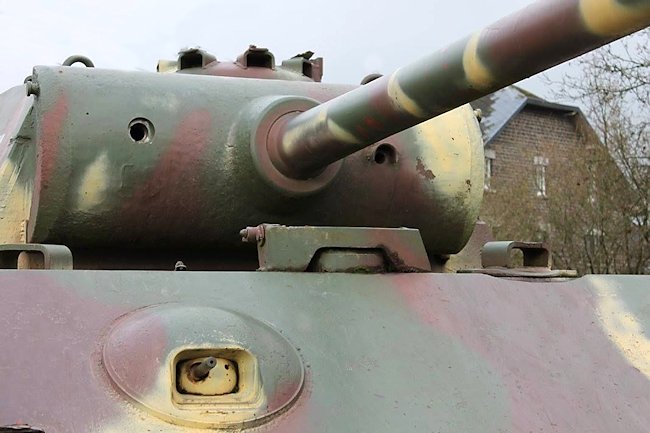
The Grandmenil Panther was armed with two machine guns, one in a ball mount in the hull and another coaxial next to the main gun in the turret.
"On our right, we came across a company of Sherman tanks. The crews had sat down and was smoking and chatting near their tanks. They were all in rows. I gave up trying to count them, but estimate the number of tanks as 80 or more. We had no choice left, we had to get past them. The American soldiers jumped aside. Before long they recognised us as German, but not until we were already past them."
"Behind us motors were whirring and tank turrets turning, but thank God that one tank was blocking the view and field of fire of another one. I had egg shaped grenades distributed to the crew in case we had to abandon the tank. I lit up a smoke generator and let it roll over the rear of the tank onto the road. Thick smoke was screaning us from behind. The situation was becoming increasingly unpleasant."
"As I noticed that there were vehicles following us, the gunner swung the turret to the six o'clock position, pacing behind us, as we moved along. He loosed off high explosive shells back in their direction and into the village. After about 300 m I halted our Panther 401 and switch the engine off. I listened to the sounds coming from behind us. I heard the noise of tanks and motors on the move. We had thrown the Americans into total confusion at their assembly point. In the distance I could hear the sounds of fighting."
"Enemy vehicles were following us again, including the Sherman, but we shot them up with accurate shellfire. Burning vehicles were blocking the road for the others. A couple of hundred metres further on, we repeated the exercise. We change course again towards the North. We left the road and on a bend found a well hidden firing position with a good view of the road. Here I stopped to let my crew get out. They stood around my turret gawping in the air. I looked at their grinning faces. Everything had worked out all right again will stop."
"We followed the advance on Grandmenil from the sounds of the fighting. Then we left our firing position and move slowly back to Manhay past burning American vehicles. There was not a German tank to meet us at the entrance of the village. Instead, there were hemmed in abandoned American tanks and vehicles. The Sherman tanks, which had capitulated were standing in the front garden is between an behind the houses. We counted 20 of them."
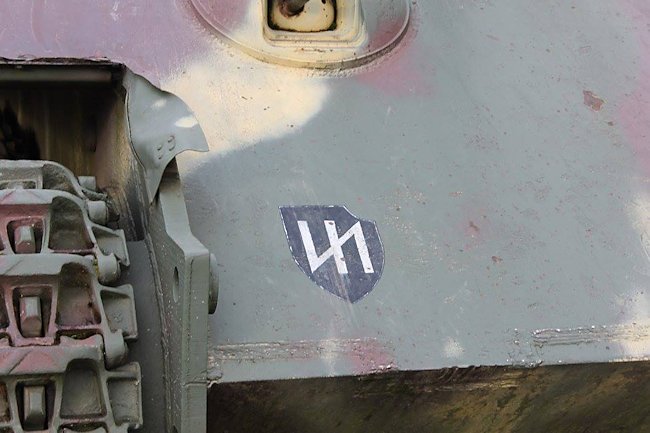
The Grandmenil Panther was part of the 2nd SS Panzer Division 'Das Reich'. That is their tactical unit badge on the front of the tank
Where can I find other preserved Panther Tanks?
- Panther Ausf. A - Wheatcroft Collection, England
- Panther Ausf. A - Befehlspanzer Munster Germany (running condition)
- Panther Ausf. A - (n° 224) Auto + Technik Museum, Sinsheim, Germany
- Panther Ausf. A - (n° 243) Auto + Technik Museum, Sinsheim, Germany
- Panther Ausf. A - (n° 413) Private Collection, Germany
- Panther Ausf. A - (n° 256) Saumur Tank Museum France
- Panther Ausf. A - (n° 211) Saumur Tank Museum France (running condition)
- Panther Ausf. A - Omaha Overlord Museum, Colleville-sur-Mer, France
- Panther Ausf. A - 501/503e RCC Mourmelon-le-Grand France
- Panther Ausf. A - (n° 201) Royal Jordanian Tank Museum, Jordan
- Panther Ausf. A - Australian Armour and Artillery Museum, Cairns, Queensland.
- Panther Ausf. A - National Armor and Cavalry Museum, Fort Benning, GA,USA
- Panther Ausf. A - U.S. Army Ordnance Museum, Fort Lee, VA, USA
- Panther Ausf. A - The Collings Foundation, Stow, MA, USA (running condition)
- Panther Ausf. A - Canadian War Museum (CWM) in Ottawa Canada
- Panther Ausf. A or D Panzermuseum, Thun, Switzerland
- Panther Ausf. D - Breda Netherlands
- Panther Ausf. G - Bovington Tank Museum England (British Built)
- Panther Ausf. G - Wehrtechnische Dienststelle, Trier, Germany (British Built)
- Panther Ausf. G - Privately owned now confiscated by police, Germany (British Built)
- Panther Ausf. G - National War and Resistance Museum, Overloon Netherlands
- Panther Ausf. G - Houffalize Belgium
- Panther Ausf. G - Grandmenil Belgium – engine, gearbox and transmission are present
- Panther Ausf. G - Celles Belgium
- Panther Ausf. G - (n° 332) Saumur Tank Museum France
- Panther Ausf. G - Kubinka Tank Museum Russia (running condition)
- Panther Ausf. G - U.S. Army Ordnance Museum, Fort Lee, VA, USA
- Panther Ausf. G - 2x National Armor and Cavalry Museum, Fort Benning, GA, USA
- Source - Pierre-Oliver Buan - http://the.shadock.free.fr/Surviving_Panzers.html
Battle of the Bulge books

